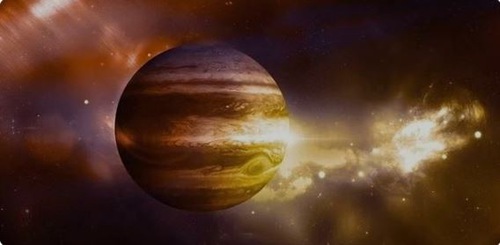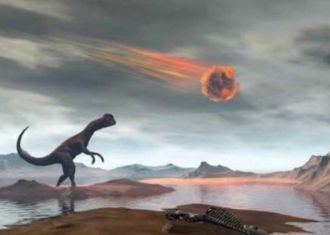(Minghui.org) According to data from the World Health Organisation (WHO) and the U.S. Centers for Disease Control and Prevention (CDC), about 1.35 million people die each year due to traffic accidents around the world. This translates to the loss of 3,700 lives per day or one death every 25 seconds.
So what about “accidents” in outer space? What if there are collisions or other types of accidents involving Earth?
In fact, they do happen from time to time, as we will discuss.
From Dinosaurs to the 20th Century
Scientists believe smaller asteroids have a greater chance of colliding with the earth. An asteroid five kilometers in diameter hits Earth about once every 10 million years; a one-kilometer asteroid strikes Earth about once every 500,000 years; a 50-meter one about once every 1,000 years, while asteroids around 10 meters in size hit the Earth’s surface about 500 times a year.
Paleontologists believe there have been five major mass extinctions since the Earth was formed. The last and most recent one occurred 66 million years ago during the Cretaceous Period. An asteroid with a diameter of between 10 and 14 kilometers hit the Earth at about 20 kilometers per second at an angle of between 45° and 60°. Equivalent to 10 teratonnes (1013 tons) of TNT or over one billion times the power of the atomic bombs that hit Hiroshima and Nagasaki, it wiped out at least 75% of all the species on Earth, including the dinosaurs.
In addition to these large impacts in prehistory, scientists have discovered smaller prehistoric impact sites that left huge craters on the earth’s surface. For example, the Barringer Meteor Cratre in Arizona in the US was formed about 50,000 years ago and was the world’s first identified site of its kind. Lake Lona in India was formed 52,000 years ago. The Rio Cuarto Crater in Argentina was caused by an asteroid impacting at a very low angle about 10,000 years ago.
In more modern times, the Tunguska event in Siberia, Russia, occurred on June 30, 1908. At 7:17 a.m., locals northwest of Lake Baikal saw a huge fireball as dazzling as the sun streak across the sky. A few minutes later, a brilliant light illuminated the entire sky, and then an explosion produced a huge shock wave. Windows were shattered, and fungiform clouds formed in the sky. Experts estimated that the power of the explosion was equivalent to 20 million tons of TNT explosives. More than 80 million trees in an area of more than 2,150 square kilometers were burned. Witnesses said that at least three people died. Scientists speculated that the explosion was caused by high-altitude fragmentation caused by a meteoroid hitting the earth.
Meteor Showers in Ancient China
There are many written records of meteor showers in ancient China. For example, Zuo Zhuan (Zuo’s Commentary) recorded: “Xinmao night in April, the stars disappear, and the stars fall like rain in the night.” In Zhu Shu Ji Nian (Bamboo Annals) it says, “In the 15th year of Emperor Gui’s (Jie) reign in the Xia Dynasty, the stars fell like rain in the night.” In the “Astronomical History” of Xin Tang Shu (New Tang Book) it says, “In May, the second year of Kaiyuan (during Emperor Xuanzong’s reign), there are stars flowing northwest passing through the North Pole. The small ones are innumerable… It did not stop until dawn.”
In 1490, during the Hongzhi period of the Ming Dynasty, what appeared to be a meteor shower occurred in Qingyang (today’s Shaanxi Province). According to Wanli Ye Huo Bian written by Shen Defu in the Ming Dynasty, in the third year of Hongzhi Emperor Xiaozong’s reign (1490 AD), “Shaanxi officials in Qingyang County reported meteorites falling like rain. The big ones were four to five jin (pounds), and the small ones were two or three. Tens of thousands of people were killed and everyone in the city fled.” Ming Shi (History of the Ming Dynasty) also described this incident: “In March of the third year of Hongzhi, countless stones of different sizes rained down in Qingyang. The big ones were like cobblestones and the small one like fox nuts.”
Scientists from NASA’s Jet Propulsion Laboratory believe that the meteor fall in Qingyang, Shaanxi, was similar to the Tunguska event in modern times. It was enough to cause disasters in highly populated areas. Scientists have found that the Qingyang event may be a fragment from the disintegration of the parent comet C/1490 Y1 of the Quadrantid meteor shower. But some scientists believe that the timing is wrong. The Quadrantid meteor shower occurs in January every year, while the Qingyang event occurs in March and April.
People in ancient China believed in the harmony of heaven, earth, and mankind. When society was in chaos, abnormal incidents or disasters could happen. During the Ming Dynasty, especially in its latter years, there were earthquakes, floods, drought, and plagues, not to mention large numbers of corrupt officials. Could the abnormal events have been a warning from the divine?
A Comet Hits Jupiter in 1994
According to astronomers, there are between 100 and 400 billion stars. Together with asteroids and comets, they number far more than the population of humankind. Compared to the earth, the diameter of the sun is 109 times larger and its mass is 330,000 times greater, which makes it more than likely that some of these objects will hit it. One astrophysicist said that a cruiser-sized object probably comes close to Earth once every 10 years.
Fortunately, incidents of this magnitude have not occurred on Earth in the past 5,000 years. We did, however, see Jupiter get hit by a comet in July 1994. As Comet Shoemaker-Levy 9 passed by the planet, it was broken apart into fragments. Fragment A slammed into Jupiter on July 16 at a speed of 60 kilometers per second. The collision fireball reached a temperature of 24,000 K (or 23,700 °C).
The largest piece, fragment G, struck Jupiter on July 18, creating a dark spot measuring 12,000 kilometers (about the size of Earth). The energy released was equivalent to 6,000,000 megatons (or 6×1012 tons) of TNT, which is 600 times the destructive capacity of all the nuclear weapons on Earth. The combined impact of the 21 fragments was equivalent to 40 million megatons of TNT (4×1013 tons). This was about four times the amount of energy that led to the fifth major mass extinction on Earth as mentioned above.
Although scientists are interested in studying the impact from the angle of astronomy and physics, how many have contemplated what would happen if comet Shoemaker-Levy 9 had hit Earth instead of Jupiter? How long will our luck hold out?

(To be continued.)
Chinese version available
(Clearwisdom)
Who Protected Mankind When These Disasters Nearly Destroyed the Earth? (Part 2)

